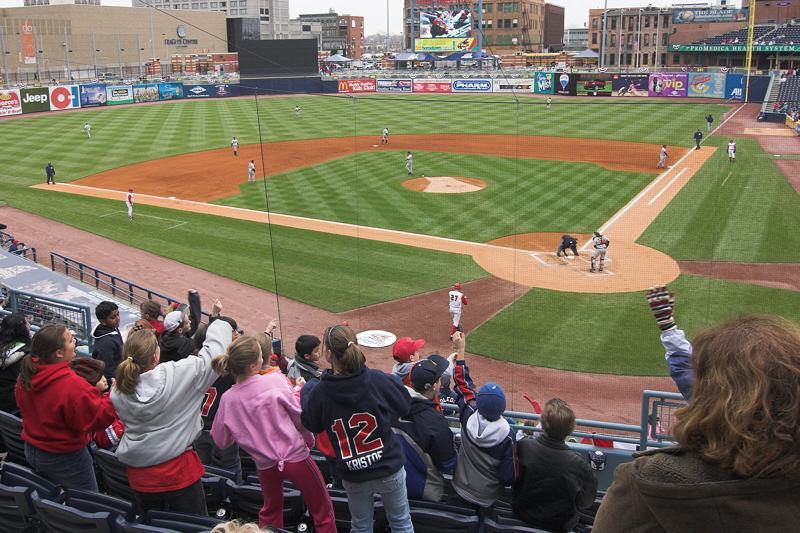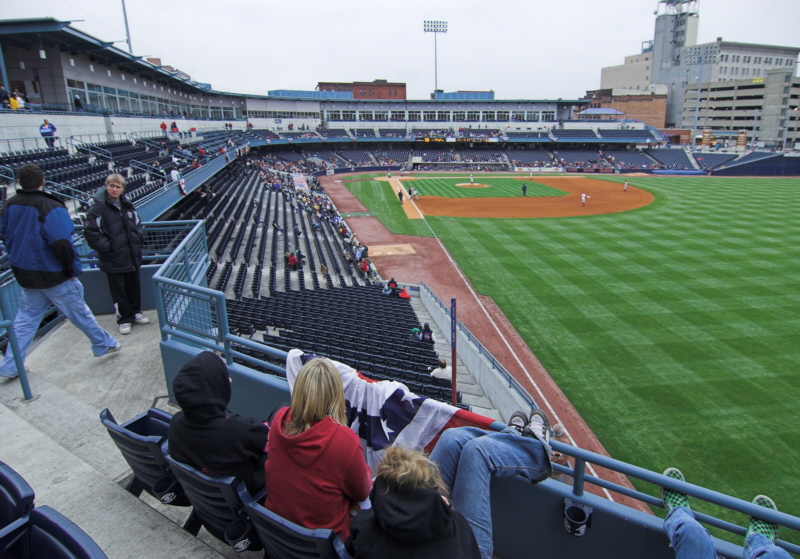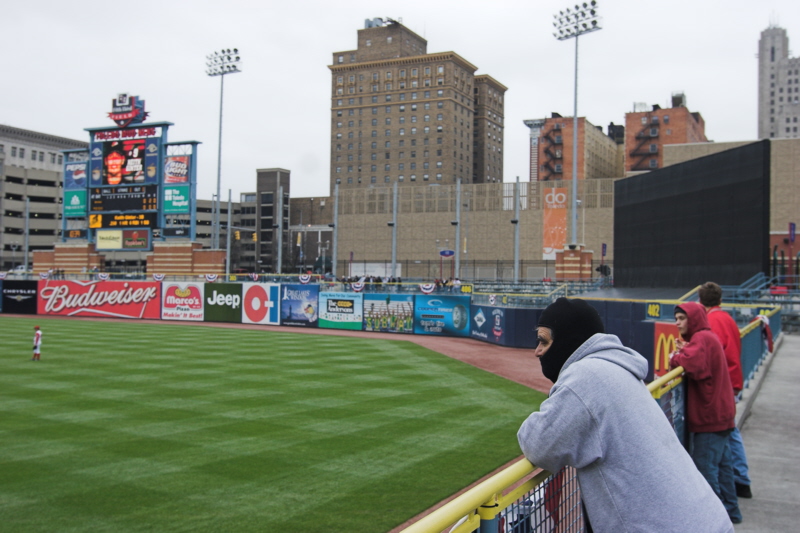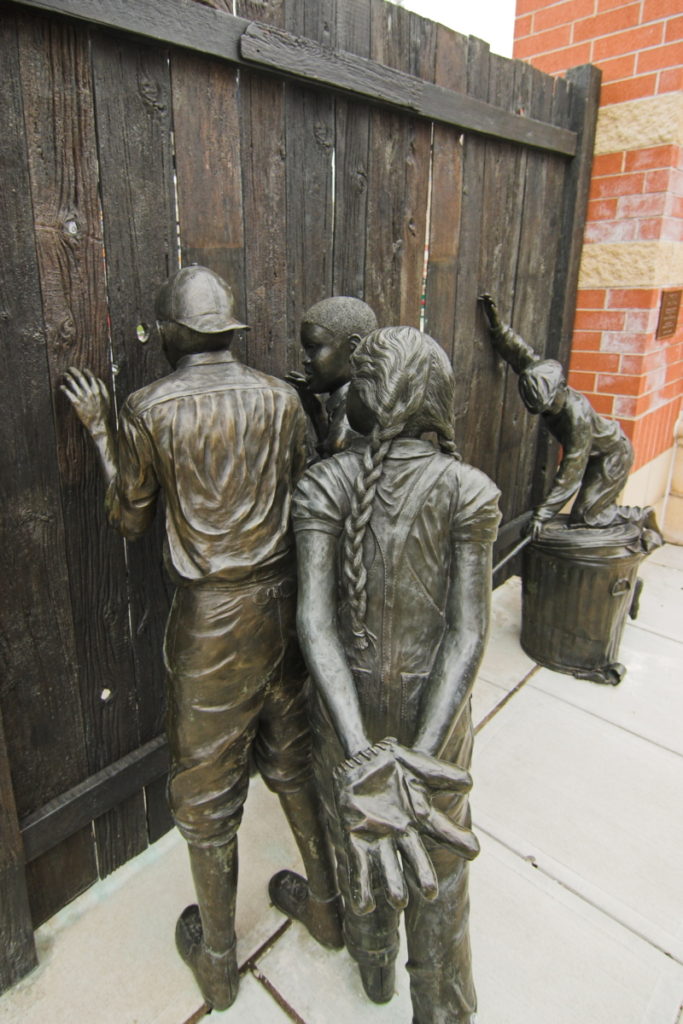Fifth Third Field is an impressive edifice that seemed to have been carved out of stone. The fact that it has helped turned Toledo’s warehouse district into the place to be during the summer is one of the more impressive feats of the young 21st century.
FAST FACTS
Year Opened: 2002
Capacity: 8,943 fixed seats; 10,300 w/standing room
Owner: Lucas County
Architects: HNTB
Construction: Lathrop Construction
Dimensions: 320L, 365LC, 412C, 365RC, 330R
Original Cost: $39 million for entire project; $31.3 million for ballpark
Playing Surface: Grass
Website: mudhens.com
Phone: 419/725-4367
Ticket Prices: Field Boxes, $9
League: International League
Parent: Detroit Tigers
Parking: Between $2 and $5
Address/Directions: 406 Washington St., Toledo, OH 43604. Directions from the north: Take I-75 South to exit 202-A (Washington Street) and turn right. Directions from the south: Take I-75 North to exit 201-B (downtown exit). Turn left onto Erie Street and then turn right onto Washington Street.
Written by: Dave Wright
Photos by: Jim Robins

“Have you been to Toledo yet?” asked an usher in Columbus. “That’s the kind of ballpark I hope we get here.”
After spending a day at this minor-league Taj Mahal, one understands why. Like its namesake in Dayton, Fifth Third Field is an impressive edifice that seemed to have been carved out of stone. The fact that it has helped turned Toledo’s warehouse district into the place to be during the summer is one of the more impressive feats of the young 21st century.
In its sixth year of business, Fifth Third has become one of the must-see stops on the minor-league tour. After all, how can you not like a park where the standing room seats are some of the best in the house and there is a statue honoring kids peeping through the fence watching a game?
Like its rival in middle of the state, Toledo has a rich baseball history. There have been some stoppages here and there but they have been playing pro ball most of the time in this northern Ohio city since 1883. In that time frame, there have seven different affiliations with major-league franchises and the city has been a member of eight different leagues. Through it all, it produced some very good players and was always considered a reliable port. They were never at the bottom of the attendance pool nor were they considered a top draw.
No longer. Toledo is one of the top dogs now.
Thanks in part to the constant prodding and stewarding of team VP/General Manager Joe Napoli….and a $39.2-million price tag, Fifth Third stands out as a beacon amid the gray landscape. Yes, you can see downtown Toledo’s skyline from inside the park. Yes, the Maumee River flows nearby (for the most part, quietly). But the ballpark’s the thing here. The success of Fifth Third (and the Mud Hens, who have won two straight IL titles) led indirectly to a deal that has seen Napoli and partners take over ECHL hockey in town and bringing other minor-league sports to town.
Ned Skeldon Stadium, Fifth Third’s predecessor, was a solid facility built in 1965 in nearby Maumee. (It was known as Lucas County Stadium until 1988 when renamed for the person who helped bring minor-league ball back to town after a nine-year absence.) There was nothing overtly bad about the place. Nor was there much room for improvement. A former racetrack, there were many seats behind posts and a lot of bleachers. It would have been practically impossible to add luxury boxes, this costing the team a revenue stream available in nearby cities.
So, when the chance came to build a build with all the bells and whistles downtown, the city (which oversees the non-profit organization that runs the team) jumped in feet first. The result is a slightly larger version of Dayton’s ballpark, the Class A facility in southern Ohio that has also no lack of admirers. The similarities are obvious. The upper deck (complete with club seats) stretches from the right-field corner halfway down the left-field line, Toledo’s Fifth Third has slightly more capacity (8,943 seats to Dayton’s 7,230).
While Dayton opted to go for a berm in right field, Toledo went for more picnic areas built up past the high outfield fence (14 feet in right). The result is fans can sit at a picnic table or stand, still be close to the action and stare down at the outfielders, a rarity in minor league baseball. As a result, the park feels cozier than most. One of the reasons is this is there are buildings basically behind you as you stand and watch the game. The ballpark is sandwiched into a city block but doesn’t feel like it.
“I like to think this park is a smaller version of Jacobs [Field in Cleveland] or Safeco [Field in Seattle],” Napoli said.
The lower deck offers a similar tromp l’image. The seats actually go back several rows but you don’t realize it immediately. The reason? The seating runs more vertically than most parks. One suspects a full house could make a person in the last couple rows feel a bit claustrophobic. But on days like when we visited (the announced attendance was around 5,000 and it seemed less than that), the park felt roomy indeed. One other bonus: The concession stands and restroom facilities are a long ways back. Because the walkways are fairly wide, spectators can watch the action and still not feel far away. If you want to get up close and personal, this is the place to do it. Some front-row seats are just six inches off the ground. Sit behind home plate and you can be closer to the batter than the pitcher is.
Picnic areas? There are three of them, one in left field and two of them in right. The concessions seemed reasonably priced, and there is even a restaurant outside the ballpark, overlooking the right-field fence. There are other nice touches like a kids’ play area in center field and plenty of wheelchair seating.
Although the Mud Hens have been hooked up with the Tigers for the past two decades (“it’s a good time to be hooked up with them,” Napoli said wryly), the Swamp Shop, the main merchandising outlet, offered much more local stuff than parent club gear. One thing really stood out: there were more offerings than usual of clothes in women’s sizes.
This is the team made famous by actor Jamie Farr in his portrayal of Corporal Klinger in the TV series “M*A*S*H.” So, it should not be surprising there is a huge picture of him and actor Harry Morgan (Colonel Potter) on the wall of the restaurant area located behind the suites. What is surprising, however, is the list of ex-Toledo players who are in baseball’s Hall of Fame. The august list includes some of the game’s great names: Casey Stengel (who played and managed in Toledo); Bill Terry, the last National League player to bat over .400; Joe McCarthy, who managed seven World Series winners; Hack Wilson, who holds a MLB record that will be hard to break (190 RBI in a season); and a current United States Senator (Jim Bunning, who managed there for two seasons after a Hall of Fame career as a pitcher with Detroit and Philadelphia.)
This kind of history seems important to Toledo fans. After all, which would you prefer to be known as: the Glass Capital of the World or the city that was Kirby Puckett’s last minor-league stop before joining the Minnesota Twins?
But Fifth Third’s legacy is what it has done to the area around it. Police on horseback patrol the area before, during and after the game. Tony Packo’s, a well-known Toledo eatery, built a second place a block from the park that does a booming business. (Odd but true fact: Several celebrities who have eaten there signed hot dog buns.) The new hockey arena will be built a couple blocks away from Fifth Third. A quiet city has new life.
The result has not gone unnoticed. The team has drawn over 500,000 each of its five years at Fifth Third. (There were 34 sellouts, including 10,300 for the game that clinched the IL championship last September.) The AAA All-Star Game was held there in 2006 and the parent club Tigers brought their Fandemonium tour to town as well.
As a result, when top-notch minor league cities are discussed, Toledo is now on equal footing with cities like Memphis and Louisville. That’s pretty heady stuff — and it remains to be seen whether this will continue for several more years.
Suffice it to say that, for now, Fifth Third is in that rare elite of minor-league ballparks. “When we started this, people said nobody will ever come to downtown Toledo,” Napoli said. “I thought they would be surprised and they have been. It’s very gratifying to see what can be accomplished.”
Fifth Third Field: Ballpark art at its finest
When you visit Toledo to see a game at Fifth Third Field, you’ll be looking forward to seeing the game in one of the great minor-league venues. Please take some time before or after the game to explore some of the finer, artful highlights of this experience.
The quality of public art in this ballpark, simply, is unsurpassed.
Most modern parks feature bronze sculpture, often on a grandiose scale. What can be far more impressive is finely detailed public art on a human scale.
Few, if any, have achieved this goal as well as Toledo.
You’re bound to notice “I Got It!” by Frank C. Gaylord II, especially if you enter from the left field side along Monroe Street. Featuring three boys in old-time uniforms with outstretched arms, the bronze sculpture faces the incoming crowd before the game and then rotates on a turntable to face the infield.
My personal favorite work of art is a little harder to find. In exquisite detail, “Who’s Up?” by Emanuel Enrique, is a sculpture integrated into the right field wall along St. Clair Street. You’ll chuckle at this knothole gang when you realize the ironic fact that this is one of the few places along the outfield fence line where you can’t catch a glimpse of the game action. The innocence and artistry of this sculpture are captivating. While its place along the outfield wall is part of the attraction, its remote location is somewhat frustrating. If you go to the trouble of visiting this ballpark, but happen to miss this fine artwork, it would be a crying shame.
More unusually placed works of art easily might be missed, especially for those prudent folks who pay attention to traffic as they cross the street onto the ballpark block. Take a little risk and look down at one of the 22 Toledo baseball-themed Manhole Covers designed by Jim Gallucci.
Now, look up as you approach the Main Entry Gates by John Rogers. Once again, the artwork features an interestingly unique design, minutely detailed on a human scale.
It is all so wonderful that a struggling Tigers ballplayer with a sense for fine art might not even mind getting sent down to Toledo.
It is clear that this level of ballpark artistry does not happen without a great deal of coordination among several diverse communities around Toledo. Kudos go out to the Arts Commission of Greater Toledo, the Mud Hens and other civic boosters who have worked together to accomplish so much.
Too often in too many communities, the arts and sports communities can’t get along. In Toledo, they appear to be getting along famously — and it shows.






